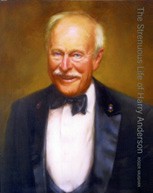This excerpt from The Strenuous Life of Harry Anderson by Roger Vaughan recounts an event caused the match racing rules to be re-written.
 The Solent is indeed a mean-spirited body of water with an extreme wind range that can change from flat calm to white caps in a London minute. An extreme tidal rise and fall of four meters (14 feet) produces ferocious currents. On a practice day with little wind, one American boat was slammed into a cage (channel marker) by the four-knot current, while another took a bite out of a teammate’s stern by misjudging the tidal effect. The American team consisted of Herman Whiton (Firecracker); Bus Mosbacher (Llanoria); Dr. George Nichols Jr. (Goose); and Mrs. James R. Sheldon (NOA, on charter). George Nichols, as it happened, was a classmate of Anderson’s from Adirondack-Florida School, an Oyster Bay neighbor, and a fellow member of the SCYC.
The Solent is indeed a mean-spirited body of water with an extreme wind range that can change from flat calm to white caps in a London minute. An extreme tidal rise and fall of four meters (14 feet) produces ferocious currents. On a practice day with little wind, one American boat was slammed into a cage (channel marker) by the four-knot current, while another took a bite out of a teammate’s stern by misjudging the tidal effect. The American team consisted of Herman Whiton (Firecracker); Bus Mosbacher (Llanoria); Dr. George Nichols Jr. (Goose); and Mrs. James R. Sheldon (NOA, on charter). George Nichols, as it happened, was a classmate of Anderson’s from Adirondack-Florida School, an Oyster Bay neighbor, and a fellow member of the SCYC.
The report on the regatta Anderson compiled is 14 pages single-spaced, complete with charts of the course and photographs. It is presented race by race, with the course, tidal situation, and wind conditions noted. The denouement of the first race will be recognized as a classic by anyone who has ever competed in the Solent. Llanoria and Goose had worked out an eight-minute lead with one leg to go to the finish. In a team race, a 1-2 finish by a team is an unbeatable combination. As Anderson wrote, “Only a miracle could prevent an American victory. The Solent, however, is an unceasing source of miracles, and one was in the making.”
Llanoria and Goose both took the port jibe on the downwind leg, and soon found themselves becalmed without steerageway. The trailing boats took the starboard jibe, and they were first to pick up an incoming southeasterly breeze that blew them to the finish. Llanoria and Goose finished next to last, and last. The lesson was not lost on Anderson. “In the fluky winds and strong tides of the Solent,” he wrote, “Llanoria and Goose should have kept further apart on the run in order that they would not fall victims of the same fate.”
Race two turned out to be the most significant of the series because of the rules question that arose. Llanoria, skippered by Bus Mosbacher, rounded the last mark with a lead of several minutes. “Suddenly an astonishing maneuver took place,” Anderson writes. “Instead of heading for the finish, Mosbacher, realizing the American team did not have a winning combination, turned Llanoria back along the leg of the course from which he had just come, tacked ahead and to leeward of two British boats, and by forcing them onto a higher course attempted to allow Goose to sail through them to leeward and secure a winning combination. It was a gallant challenge, but Goose was too far astern for it to work.” For his efforts, Mosbacher was beaten across the line by one second, losing the always-valuable ¼ point for placing first. The London Times gushed that it was “a day of prolonged, and at times scarcely bearable, excitement.”
That Mosbacher’s gambit didn’t work out wasn’t the question. The lively post-race discussions at the bar centered around the propriety, under the racing rules, of a boat turning back to help a teammate by harassing a competitor. “It was the consensus of both teams,” Anderson wrote, “that the rules do not, and never have been adequately explicit to cover situations occurring in team racing events.” This led a few years later to the formation of a large committee that included Mosbacher, Whiton, and Anderson to draft a supplementary set of rules for intercollegiate team racing in the United States. The final code was completed by a subcommittee consisting of George O’Day, William S. Cox, and Henry H. Anderson Jr., and later adopted with little variation by the North American Yacht Racing Union (NAYRU) . . . and later (with one variation consisting of a complete prohibition on the practice of going onto another leg of the course to engage an opponent) by the Royal Yachting Association.
The biography of a sailor, educator, philanthropist, international yachting ambassador and 2014 inductee into the National Sailing Hall of Fame, The Strenuous Life of Harry Anderson is published by Mystic Seaport. To order a copy, visit store.mysticseaport.org/the-strenuous-life-of-harry-anderson.html.




